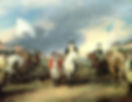This Day in History: The American victory at Yorktown
- tara
- Oct 17, 2024
- 2 min read
On this day in 1781, British General Lord Charles Cornwallis raises a white flag of surrender to American General George Washington. An official surrender would come on October 19, effectively ending the American Revolution.
Americans had won an impossible victory!

They had been fighting for 6.5 long years—ever since the Battles of Lexington and Concord in April 1775. Their revolution was fought against a very powerful British military. Often, the Americans had survived on sheer guts and perseverance. They lacked funds. They lacked military supplies. They suffered through long, cold winters. They lost soldiers to smallpox. Sometimes, even their basic needs—food, shoes and clothes—went unmet.
Through it all, Washington held the army together. Yes, he made strategic errors, and he has been criticized for it. There are undoubtedly military leaders with better qualifications or better tactical skills. However, few men could have done what Washington did as a leader. Washington held his army together, through all their difficulties, through sheer strength of will. His men loved, revered, and trusted him. For Americans, he was the right man in the right place at the right time.
Washington himself viewed the victory as a miracle. The day after Cornwallis’s surrender, he issued the following general orders to his troops:
“Divine Service is to be performed tomorrow in the several Brigades or Divisions. The Commander in Chief earnestly recommends that the troops not on duty should universally attend with that seriousness of Deportment and gratitude of Heart which the recognition of such reiterated and astonishing interpositions of Providence demand of us.”
Today, then, is the anniversary of a miracle. Let’s celebrate and defend the freedom that was achieved for us that day.
Enjoyed this post? More Revolutionary War
stories can be found on my website, HERE.
Primary Sources & Further Reading:
David McCullough, 1776 (2005)
George Washington, General Orders (October 20, 1781)
James Thomas Flexner, Washington: The Indispensable Man (1994 edition)
John Ferling, Almost a Miracle: The American Victory in the War of Independence (2007)
Joseph Ellis, His Excellency: George Washington (2004)


